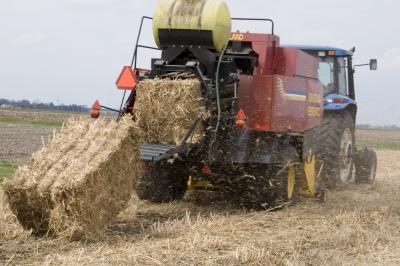CHAMPAIGN, lll. — Research into biofuel crops such as switchgrass and Miscanthus has focused mainly on how to grow these crops and convert them into fuels. But many steps lead from the farm to the biorefinery, and each could help or hinder the growth of this new industry. A new computer model developed at the University of Illinois can simplify this transition, researchers say. The model can run millions of simulations, optimizing operations to bring down costs, reduce greenhouse gas emissions or achieve other goals.
"Biomass from the field will not just show up magically at the biorefinery," said agricultural and biological engineering professor and department head K.C. Ting, who developed the model with Energy Biosciences Institute research professor Yogendra Shastri and agricultural and biological engineering professors Alan Hansen and Luis Rodriguez. "You have to harvest, transport, store and deliver," he said. The institute, funded by BP, supported the research. Ting, Hansen and Rodriguez are affiliates of the Institute for Genomic Biology at Illinois.
Shastri, who built the model, said the goal was to "consider all these operations together and find out the best system, not just the best harvester or the best method of storage, but a system that works together to achieve a given goal."
In this case, the goal was to minimize the cost of the entire system, he said.
The model, named BioFeed, is described in papers in the journals Biofuels, Bioproducts and Biorefining; Biological Engineering; Biomass and Bioenergy; and Computers and Electronics in Agriculture.
The model took into account regional attributes such as weather, crop yield, farm size and transport distances, Shastri said. The model can optimize more than 300,000 variables, he said, including harvest schedules, equipment selection, storage sizing, transport distances and the logistics of moving the biomass from place to place.
As a test, the researchers used the model to optimize biomass production for a 13-county region in southern Illinois. (BioFeed can be adapted to analyze any region of the world, the researchers said.)
A major challenge of the emerging biofuels industry is the need for a vast and steady stream of plant biomass, the researchers said.
"If the biorefinery capacity is 50 million gallons of biofuel per year, you need to deliver roughly 1,500 to 2,000 tons of biomass per day," Ting said. "It's not a trivial task."
"Ideally, the biorefinery is expecting year-round delivery of biomass, and yet the harvesting season is a very short portion of the year and greatly dependent on weather," Hansen said. A January or February harvest, which most agronomists recommend for Miscanthus in the Midwest, means farmers must bring in their crop in some of the worst weather of the year, he said. This can cause expensive delays. BioFeed found that a November harvest would significantly reduce weather-related costs, which must be weighed against the potentially higher fertilization needed the following spring.

Among the many variables the new computer model takes into account, harvest timing and technology is key. Here a traditional baler is used to harvest Miscanthus x giganteus, a tall perennial grass that can be harvested in late fall or winter.
(Photo Credit: Stephen P. Long)
The model also found that storing the harvested grasses in a barn or other protected site on the farm would – in most cases – reduce the overall cost of the system more than if it were stored uncovered on a farm or at a centralized facility.
Each optimized solution will have its drawbacks, however, the researchers said.
"If you reduce costs in one part of the system, you may increase costs somewhere else," Ting said. For example, while on-farm storage can reduce the total expense of harvesting, storing and getting material to the biorefinery, it will increase the farmer's share of the overall cost.
BioFeed allows policymakers, growers, investors, biorefinery owners, researchers and other interested parties to learn from simulations without having to actually build the system first, the researchers said.
"There are so many factors to consider, so many ways to operate, so many scenarios, so many potential policy changes," Ting said. "That's why the optimization tool itself is so important."
"BioFeed is optimizing as if you have control of everything, as if you own everything," Ting said. Individual stakeholders within the system – such as farmers or those building new bio-refineries – will want to maximize their own profits, however. This drives up the cost of the whole system, "but it also makes everybody more willing to participate," he said.
To study this, the researchers are building another model that considers how farmers and other stakeholders are likely to behave given various economic and regulatory factors. This "agent-based" approach is described in a paper in BioEnergy Research.

Energy Biosciences Institute professor Yogendra Shastri, left, and University of Illinois agricultural and biological engineering professors Alan Hansen, center, and K.C. Ting developed a computer model that optimizes operations between the farm and the biorefinery.
(Photo Credit: L. Brian Stauffer)